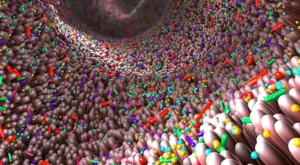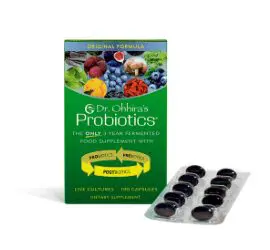Ross Pelton, RPh, CCN
March 15, 2019
Probiotic bacteria are amazing little chemical manufacturing plants. They break down dietary fibers and convert them into a wide range of compounds that are referred to as postbiotic metabolites. Postbiotic metabolites are the new frontier in microbiome science. Scientists are learning that postbiotic metabolites are the master health-regulating compounds in the body. They play a role in regulating every organ system, including your immune system and your brain.
Microbiome diversity is one of the most critical factors determining your overall health. Numerous human clinical trials report that a more diverse microbiome equates to better health.1,2 Microbiome diversity refers to how many different strains of bacteria are present in the intestinal tract. A wider range of different types of bacteria is a more diverse microbiome, which generally equates to better health.
The reason greater microbiome diversity promotes better health is because different kinds probiotic bacteria produce different kinds of postbiotic metabolites. Here’s an analogy. Your probiotic bacteria produce postbiotic metabolites, which are the tools that make up your “tool kit” for good health. People who have a wider range of tools in their microbiome “tool kit” have a more effective tool kit, which does a better job regulating health throughout the body.
In The Mind-Gut Connection, respected scientist and author Emeran Mayer, MD states that our bacteria utilize the information in their millions of genes to transform the food people eat into “hundreds of thousands of metabolites.”3 However, the ability of your probiotic bacteria to make postbiotic metabolites is entirely dependent on the amount and the diversity of dietary fiber you supply them with.
The FIBER GAP: America’s #1 Nutritional Deficiency
Fiber is the required food for your probiotic bacteria. A recent article titled “The Fiber Gap and the Disappearing Gut Microbiome: Implications for Human Nutrition” discusses how low fiber diets are affecting people’s microbiome and ultimately, their health. The authors of this study report that an alarming 90% of children and adults in America DO NOT consume the recommended amount of daily dietary fiber.4 Scientific studies provide convincing evidence that the microbiome is the very foundation of health.5,6 It is becoming alarmingly clear that the Standard American Diet, known as the SAD diet, is more than just SAD, it is killing people.7 Americans lack both quantity and diversity of dietary fiber.
It is not enough to just take probiotics, you must also learn to feed your probiotic bacteria well. Different strains of probiotic bacteria thrive on different kinds of fibers that are present in different kinds of plant-based foods. Eating a more diverse fiber-rich diet is essential for the development and maintenance of a healthier microbiome. Millions of people are probably getting limited benefit from the probiotics they take because they are not consuming a diverse range of fiber-rich foods.
For an easy way to increase the diversity of fiber-rich foods in your daily diet, I suggest you watch my 8-minute YouTube video which teaches people how to save an enormous amount of time making salads that contain a wide variety of fiber-rich vegetables.
Postbiotic metabolites have many health-regulating functions in the body. Some of their more well-known functions include the regulation of digestion, absorption of nutrients, detoxification, regulation of the immune system, gut-brain communication, and much more.
It is beyond the scope of this article to attempt to name and list the health-regulating effects of thousands of microbial metabolites/postbiotic metabolites that been identified to date. A review article published in 2002 reported that over 22,000 postbiotic metabolites have been identified in the scientific literature.8
Some of the better known postbiotic metabolites include the following:
- B-vitamin synthesis (biotin, cobalamin, folates, nicotinic acid, pantothenic acid, pyridoxine, riboflavin, and thiamine9
- Vitamin K10
- Short-chain fatty acids (SCFAs): acetic, propionic and butyric acid11
- Glutathione: synthesized by Lactobacillus fermentum ME3.12
- Antimicrobial peptides (AMPs)13
- Phenyllactic acid14
- D-amino acids15
- Hydrogen peroxide16
- Volatile organic compounds (VOCs)17
- Phytoestrogens: Equol, enterolactone, enterodiol18
- Urolithin A and urolithin B19
- Fulvic acids20
Dr. Ohhira’s Probiotics is a fermented food product that is produced utilizing a multi-year fermentation production process. Dozens of different kinds of organically grown foods (vegetables, fruits, seaweeds and mushrooms) are chopped and shredded, and then added to the fermentation vats along with 13 strains of live probiotic bacteria. Then the bacteria are allowed to ferment and digest the high-fiber prebiotic foods for 3 years (Original Formula) or 5 years (Professional Formula). During this time the bacteria produce a multitude of postbiotic metabolites.
Probiotics vs Postbiotic Metabolites: When regular probiotic products are ingested, the bacteria must locate fiber-rich foods when they arrive in the intestines and then begin the process of breaking down the fibers and converting them into postbiotic metabolites. This process takes time.
Research conducted by an independent laboratory in Japan reported that Dr. Ohhira’s Probiotics contain over 400 different postbiotic metabolites as a result of the long-term, multi-year fermentation production process.21 This explains why Dr. Ohhira’s Probiotics have achieved a reputation for rapidly improving dysbiosis-related intestinal symptoms. When taken, the postbiotic metabolites in Dr. Ohhira’s Probiotics immediately begin to initiate healthy changes in the intestinal microbiome ecosystem.
Dr. Ohhira’s Probiotics work fast because they directly deliver postbiotic metabolites. That’s THE DR. OHHIRA’S DIFFERENCE.
For more information on postbiotic metabolites, you can listen to this podcast interview I did with the publisher of Natural Medicine Journal – and you can earn CE credit in the process!
REFERENCES
- Tuddenham S and Sears CY. The Intestinal Microbiome and Health. Curr Opin Infect Dis. 2015 Oct;28(5): 464-470.
- Claesson MJ, et al. Gut microbiota composition correlates with diet and health in the elderly. Nature. 2012 Aug 9;488(7410):178–184.
- Mayer, Emeran. “The Mind-Gut Connection” New York: Harper Collins, 2016.
- Clemens R. et al. Filling America’s Fiber Intake Gap: Summary of a Roundtable to Probe Realistic Solutions with a Focus on Grain-Based Foods. J Nutr. 2012 July; 142(7): 1390S-1401S.
- Lynch SV, and Pedersen O. The Human Intestinal Microbiome in Health and Disease. N Engl J Med. 2016;375:2369-2379.
- Cho I, and Blaser MJ. The human microbiome: at the interface of health and disease. Nature Reviews Genetics. 2012;13:260-270.
- Grotto D and Zied E. The Standard American Diet and its relationship to the health status of Americans. Nutr Clin Pract. 2010 Dec;25(6):603-12.
- Berdy J. Bioactive Microbial Metabolites. J. Antibiot. 2005;58(1):1.26.
- Hill MJ. Intestinal flora and endogenous vitamin synthesis. Eur J Cancer Prev. 1997;6:S43–S45.
- Hill, M. J. (1997). Intestinal flora and endogenous vitamin synthesis. Eur. J. Cancer Prevent. 6:S43.
- Morrison DJ and Preeston T. Formation of short chain fatty acids by the gut microbiota and their impact on human metabolism. Gut Microbes. 2016 May 3;7(3):189-200.
- Mikelsaar et al., Lactobacillus fermentum ME-3: an anti-microbial and anti-oxidative probiotic. Microb Ecol Health Dis. 2009;21(1):1-27.
- Dobson A, et al. Bacteriocin Production: a Probiotic Trait? Appl Environ Microbiol. 2012:78(1):1-6.
- Ohhira I, et al. Identification of 3-phenyllactic acid as a possible antibacterial substances produced by Enterococcus faecalis TH10. Biocontrol Science. 2004;9(3):77-81.
- Cava F, et al. Emerging knowledge of regulatory roles in D-amino acids in bacteria. Cell Mil Life Sci. 2011 Mar;68(5):817-831.
- Hertzberger R, et al. H2O2 Production in Species of the Lactobacillus acidophilus Group: a Central Role for a Novel NADH-Dependent Flavin Reductase. Appl Environ Microbiol. Jan 2014.80(7):2229-2239.
- Bos LD, et al. Volatile Metabolites of Pathogens: A Systemic Review. PLoS Pathog. 2013 May;9(5):e1003311.
- Frandenfeld CL, et al. Obesity prevalence in relation to gut microbial environments capable of producing equol or O-desmethylangolensin from the isoflavone daidzein. Eur J Clin Nutr. 2014;68:526-530.
- Larrosa M, et al. Urolithins, Ellagic Acid-Derived Metabolites Produced by Human Colonic Microflora, Exhibit Estrogenic and Antiestrogenic Activities. J Agric Food Chem. 2006;54(5):1611-1620.
- Fulvic acids: Biobank
- Metabolomic Analysis conducted on OM-X (Dr. Ohhira’s Probiotics) at Human Metabolome Technology Japan, Inc. 2017.




